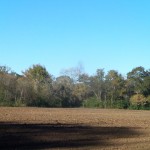Whitetail hunters across the country are busy planting their food plots for the fall season. Land is tilled, sprayed, fertilized and planted all in hopes of reaping giant bucks in October or November.
For many, the questions are wide and far when it comes to planting food plots. Questions range from where to locate plots on your property, to how large the plots should be to what to plant, and so on. Here are some basic ideas to keep in mind when you begin this process.
Location: This is answered with what the purpose of the plot is for. Some plots are intended to feed the deer and there are no intentions of hunting them, while others are killing plots and their sole purpose is to draw the deer to a location near an established stand. Plots intended for food only should be located near thick cover so the deer can access it easily. It’s best to place these in more open areas with cover nearby. One favorite method is to surround the plots with native warm season grasses. These provide excellent cover and never get too big to see over when monitoring the deer.
Whereas killing plots are much smaller and ¼ acre or less, and are located along travel corridors and near water. These are intended to bring the deer by when traveling to and from the feed plots. These are usually further away from bedding areas to get the deer committed. On smaller properties, plots should be located towards the middle of the property to draw the deer into the middle of the property and away from competing landowners. Several small plots are better than one big one, but sometimes the location is dictated by the terrain. Something is better than nothing.
What to Plant: This is a very confusing and saturated market. A lot of the planting is purely preference. Most of the top brands of seeds and blends are all good. Perhaps the best advice here is to do a soil test, and plant the varieties that will perform the best in your location. Here in South Carolina and most of the southeast, it’s hard to beat soy beans. Soy beans are one of the most favorite foods of southern whitetails. If anything the issue is preventing them from decimating the crop before it has a chance to mature. Fencing is almost always mandatory on smaller plots. The advantages of soy beans are many. These include; inexpensive, easy to plant, tolerant of drought, and many soil types. If you can protect the beans to maturity, leave them all through the winter. Deer will benefit from the lush green foliage and from the seeds and pods. In fact, the husks of the soy beans carry more protein than white oak acorns. Leaving the beans through the winter will be very beneficial to your herd.
If soy beans isn’t your thing, most blends that contain cereal grains (oats, Wheat, barley, etc) with brassicas is very hard to beat. However for long range planning in the south, a plot full of clover will remain green all winter and provide excellent browse for your deer. We’ll discuss more about clover later in the fall when it’s more optimal for planting. For now though, it’s important to get everything in the ground, if you haven’t planted yet, its time.
Also, for other species now is the time to get it going – Dove hunters, need to have their sunflowers, millet and corn planted to reap benefits for the opening season. Duck hunters should be getting their rice and corn planted for fall flooding.
Regardless of your species, June is the latest you should be planting for fall hunting. The Quality Deer Management Association has a host of information on how to and what to plant for your deer herd. If you haven’t joined this organization yet, don’t put it off any longer. Join the QDMA and reap the benefits of the knowledge this organization has to offer.





